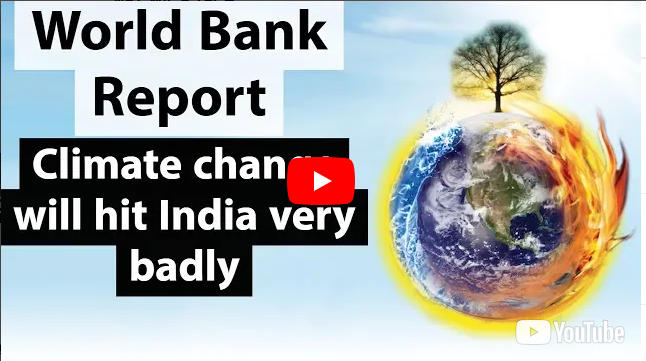Table of Contents


• Rising temperatures and changing monsoon rainfall patterns from climate change could cost India 2.8 percent of GDP and depress the living standards of nearly half the country’s
population by 2050, a World Bank report says.
• “South Asia’s Hotspots: The Impact of Temperature and Precipitation Changes on Living Standards”, almost half of South Asia’s population, including India, now lives in the
vulnerable areas and will suffer from –
• declining living standards
• agricultural yields, lower labour productivity or related health impacts.
• water stressed.
• India’s average annual temperatures are expected to rise by 1.00°C to 2°C by 2050 even if preventive measures are taken along the lines of those recommended by the Paris
climate change agreement of 2015.
• If no measures are taken average temperatures in India are predicted to increase by 1.5°C to 3°C.
• In India today, approximately 600 million people live in locations that could either become moderate or severe
hotspots by 2050 under a business-as-usual scenario, the report says.
• States in the central, northern and north-western parts of India emerge as most vulnerable to changes in average temperature and precipitation.
• report’s analysis, by 2050 Chhattisgarh and Madhya Pradesh are predicted to be the top two climate hotspot states and are likely to experience a decline of more
than 9 percent in their living standards, followed by Rajasthan, Uttar Pradesh, and Maharashtra.
• Seven out of the top 10 most-affected hotspot districts will belong to the Vidarbha region of
Maharashtra.
• The report defines hotspot as a location where changes in average temperature and precipitation will have a negative effect on living standards. These hotspots are not only necessarily higher temperature zones than the surrounding areas, but also reflect the local population’s socio-economic capacity to cope with the climatic changes.
• report provides options to prioritize investments and strategies to build local resilience to climate change.
• To offset the negative economic impact in India, for example, the analysis suggests enhancing educational attainment, reducing water stress, and improving job opportunities in the non agricultural sectors.
• Rainfall-el- nino, IOD, –AGRICULTURE- food security • STABILITY OF CLIMATE—soil erosion-drought.
• Rainfall reduced in three decades
• Living standards- water availability,
• Output of people
• People to go below poverty line
• Hygiene-health-diseases
SOLUTIONS
• Climate sensitive technology
• Forest and floodplains to be conserved
• Western style of consumption—not to followed
• Disaster preparedness
• Climate impact assessment
• Parsimony
• Environment diplomacy-not unilaterally
• Fight both internationally and internally





















 WhatsApp
WhatsApp